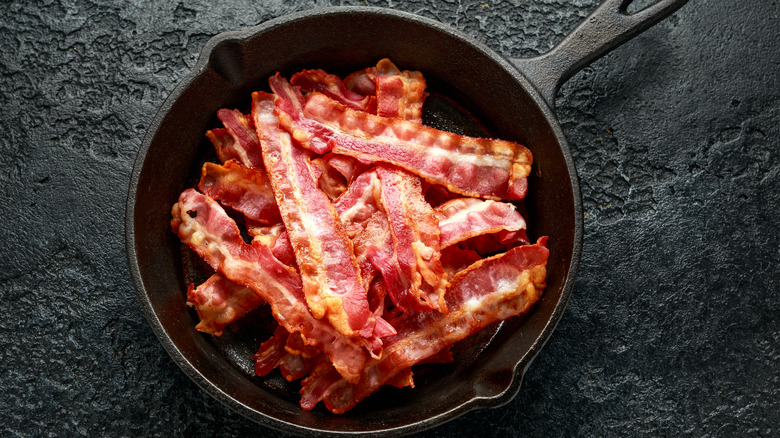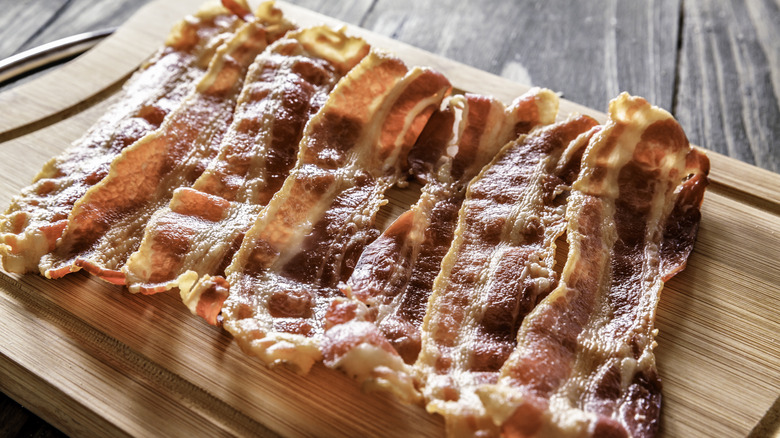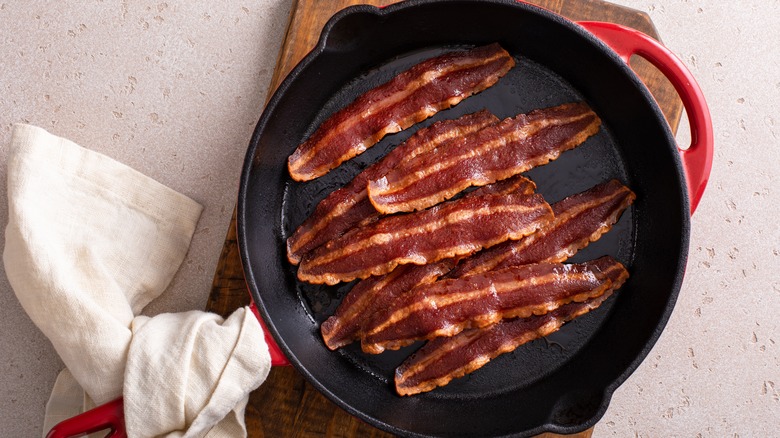Why You Should Never Use A Hot Pan To Cook Bacon
There are several methods of cooking bacon, each with its own merits, but for the most control over its doneness, nothing beats cooking it on the stovetop. Sure, it splatters while crackling in the skillet, but if you're serving bacon lovers who prefer it crispy and others who like it a bit chewy, this is the only way to go.
A common mistake when cooking bacon on the stovetop is preheating the pan. Contrary to sauteing other dishes, placing raw bacon in a hot frying pan causes the strips to seize and shrivel, cooking the protein too quickly and leaving chewy pockets of fat.
To render the fat and achieve either chewy or crispy bacon, it needs to cook slowly, which is why starting in a cold pan is essential. As the pan and bacon heat together, the fat melts while the meat crisps. Slowly rendering the bacon fat also yields more drippings, which can (and should) be saved for flavoring other dishes. Bacon grease is liquid gold, and can be stored in a sealable container in the refrigerator, adding umami and smokiness to various recipes.
Tips for cooking bacon
To ensure even cooking as the pan heats, start with bacon that's at room temperature. Remove the bacon from the refrigerator about 15 minutes before cooking to allow the fat to render more slowly.
Choose high-quality bacon that's not too thin. Less expensive brands often contain high sugar amounts, which can burn quickly in a hot pan. Even if you prefer extra crispy bacon, cook it slowly over medium-low heat for the best results. Cooking the meat at a high temperature can cause uneven cooking, with some parts burnt and others fatty. It's advisable not to rush the process for optimal results.
If you're preparing bacon for a crowd, cook it in batches in a frying pan, or consider using the oven. A sheet pan allows you to cook more bacon at once with excellent results and minimal mess. Overcrowding the frying pan leads to the meat steaming rather than crisping. Grey, limp bacon is just sad.
The best pan to cook bacon in
The recurring theme to perfectly cooked bacon is slow and steady cooking, making the choice of pan essential. Avoid thin aluminum or stainless steel skillets, as they can cause uneven cooking, resulting in both burnt and undercooked bacon in the same pan. The ideal frying pan should heat up slowly and retain heat well; a cast iron skillet is an excellent choice. An enamel-coated cast iron pan is also effective, but take care not to scratch the surface with metal utensils.
The seasoned surface of cast iron means bacon won't stick and burn. Its heavy bottom allows it to heat up gradually, effectively rendering the fat from the bacon. Thanks to the durability of cast iron, which can last for generations, you can use metal tongs to flip the bacon without worrying about scratching the pan.
Cooking with fat on a cast iron surface adds a protective layer, enhancing its durability. Regularly frying bacon every weekend helps maintain your cookware in top condition for future generations — a true win-win. However, it's recommended to wipe them with a dry cloth for cleaning, as animal fats can become rancid if left at room temperature.



